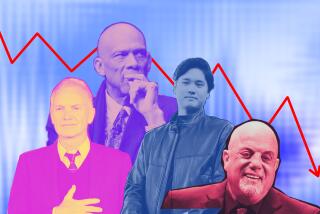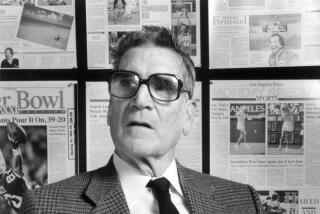Some People Put More Stock in Numbers Than Others
An innumerate person, according to the dictionary, is one who lacks the knowledge necessary to deal with mathematical concepts.
I am one.
The height of my mastery of mathematics is the ability to calculate a 20% tip on a dinner tab. I do this by calculating a 10% tip and doubling it.
I have no idea how to calculate the odds on a sporting event or the lottery. However, the fact that I have bought only one lottery ticket suggests that I grasp my infinitesimal chance of winning.
One might think of numbers as being unchanging in value; but that is not so. I remember when a millionaire was thought to be rich beyond dreams; he could buy anything his heart desired; he would never run out of money.
But in those days a pitcher like Sandy Koufax had to hold out on the Dodgers to get $125,000 a year, a salary that would hardly attract a batboy these days. What would Sandy be worth now? Five million a season?
Today billionaires are almost as commonplace as millionaires were in 1950. Writing in Newsweek, John Allen Paulos points out that if you saved $1 every second for 12 days you would have a million dollars. To save $1 billion would take 32 years.
Paulos observes that “innumerates” don’t understand probabilities and thus worry about the wrong things. He points out that most of us believe a car accident is a minor risk of local travel, while being killed by terrorists is seen as a major risk of international travel. In fact, he says, in 1985, a bad year, 39 Americans were killed by terrorists--one in 7,000; on the other hand, the chances of dying in an automobile accident are one in 5,300.
In his most recent book, “Bully for Brontosaurus” (Norton), the brilliant evolutionary biologist Stephen Jay Gould devotes one of his charming chapters to statistics and our misunderstanding of them. Obviously a baseball fan, Gould states that Joe DiMaggio’s 1941 run of safe hits in 56 games “is the greatest accomplishment in the history of baseball, if not all modern sport.”
He points out that other great achievements are barely superior to their runners-up: Roger Maris’ 61 home runs in 1961, edging Babe Ruth’s 60 in 1927 and 59 in 1921, and Hank Greenberg’s 58 in 1938 and Jimmy Foxx’s 58 in 1932. Such records, achieved over a full season, have “a certain majesty,” Gould allows, “but they don’t demand unfailing consistency every single day. A streak must be absolutely exceptionless; you are not allowed a single day of subpar play, or even bad luck.”
Meanwhile, he dismantles a myth cherished by almost every sportswriter and fan--the phenomenon in basketball known as “hot hands,” in which a player doesn’t seem able to miss. “The only problem,” he says, “is that no such phenomenon exists.”
Tests show, he says, that the probability of making a basket does not rise after a successful shot. The number of runs, or baskets in succession, was no greater than what a standard random, or coin-tossing, model would predict. “If the chance of making each basket is 0.5, for example, a reasonable value for good shooters, five hits in a row will occur on average once in 32 sequences--just as you can expect to toss five successive heads about once in 32 times.”
Gould notes that his fellow baseball fan, Nobel Laureate physicist Ed Purcell, has concluded that “nothing ever happened in baseball above and beyond the frequency predicted by coin-tossing methods.”
In an essay called “The Median Isn’t the Message,” Gould tells how his understanding of statistics turned out to be “profoundly nurturant and life-giving.”
After surgery for a rare stomach cancer, Gould asked his doctor what was the best literature on his disease, mesothelioma. In her only departure from frankness, she told him that it wasn’t worth reading.
He read the literature extensively and found out why. He learned that mesothelioma is incurable, with a median mortality of only eight months after discovery.
“When I learned about the eight-month median, my first intelligent reaction was: Fine, half the people will live longer; now what are my chances of being in that half? I read for a furious and nervous half hour and concluded, with relief: damned good. I possessed every one of the characteristics conferring a probability of longer life: I was young; my disease had been recognized in a relatively early stage; I would receive the nation’s best medical treatment; I had the world to live for; I knew how to read the data properly and not despair.”
A footnote says: “So far so good.”
I wish him Joe DiMaggio’s luck.
More to Read
Go beyond the scoreboard
Get the latest on L.A.'s teams in the daily Sports Report newsletter.
You may occasionally receive promotional content from the Los Angeles Times.










